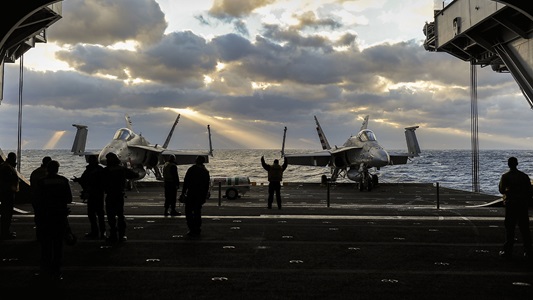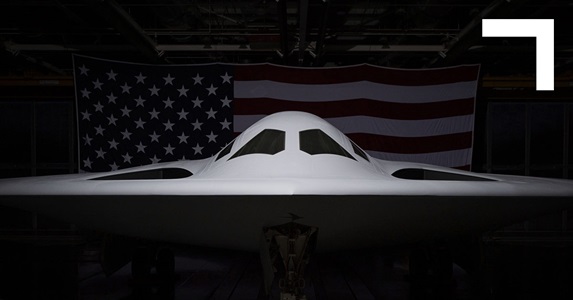Northrop Grumman delivers advanced technology and proven performance – positioning the U.S. Navy for maritime air dominance.
Elevating the Mission
Modernizing the E-2D to Keep Threats at Bay
By Elizabeth Counsman
How many aircraft can stand the test of time, adapting to meet ever-changing global threats? At Northrop Grumman, the E-2D Advanced Hawkeye is redefining mission excellence, evolving with modernized capabilities to stay ahead in an increasingly complex battlespace.
It represents the latest in a line of airborne early warning and command and control aircraft that stretches back over 60 years.
The E-2D has redefined its role by providing strategic oversight, flexibility and advanced capabilities. More than an early-warning aircraft, it now supports a broad variety of missions. The aircraft is so valuable, in fact, that every U.S. Navy aircraft carrier deploys with an E-2C or an E-2D.
Modernizing for Unmatched Mission Edge
The key to the E-2D’s continued relevance is Northrop Grumman’s commitment to modernization of the platform. Over the 17-year life of the aircraft’s latest iteration, Northrop Grumman has delivered five major updates, expanding its capabilities to include integrated air and missile defense, electronic warfare, air traffic control, combat search and rescue, humanitarian relief, border security, and counter-drug operations.
The E-2D airborne early warning command and control aircraft provides a 360-degree surveillance picture of all targets in its area, whether over water or land. Its advanced radar system — powered by digital computing and techniques like advanced electronic scanning — provides powerful detection capability and ensures a unified Common Operating Picture that connects all command levels.
Automation has also revolutionized the E-2D’s operations. Tasks like target tracking, radar fine-tuning and reporting are now largely automated, freeing the crew to focus on mission-critical objectives. Additionally, pilots can access a full range of mission functions directly from the cockpit, significantly reducing manpower requirements compared to earlier aircraft generations. Another breakthrough is the aerial refueling capability, which extends the flight endurance of the Advanced Hawkeye to more than eight hours, enhancing fleet protection and efficiency.
Collaborating for Next Generation Innovation
Building on a rich history of innovation, Northrop Grumman has ensured the E-2D remains integral to global defense forces well into the future.
“Northrop Grumman collaborated with the U.S. Navy on the E-2D Advanced Hawkeye program to ensure with this fleet modernization that we continue to outpace evolving threats into the 2040s and beyond,” said Janice Zilch, vice president, Multi-Domain Command and Control programs. We continue to invest in digital capabilities across the enterprise to assist in rapidly designing, building, testing and sustaining programs for our customers, and we will incorporate these advanced capabilities into the E-2D Advanced Hawkeye as part of Delta System Software Configuration 6 (DSSC 6).
The next planned upgrade will improve operational availability, software resiliency and security and strengthen interoperability for a seamless command and control experience. To achieve this, Northrop Grumman has embraced a strategic shift to model-based systems engineering and is converting legacy efforts to modern digital environments. The new mission computers and displays use an agile, open mission systems approach, allowing the rapid integration of new technologies and ensuring the E-2D remains adaptable to future threats.
“Threats advance,” said Zyad Hajo, Northrop Grumman airborne systems operator. “You have to change things and constantly think of the next incremental leap to keep ahead — always advancing the technology.” The E-2D's architecture, built on open standards, also reduces integration risks and supports third-party software, leveraging commercial off-the-shelf equipment to maximize flexibility.
Investing in New Capabilities and Sustainment
Northrop Grumman is also modernizing the E-2D’s maintenance and sustainability to ensure its longevity. By incorporating machine learning and artificial intelligence, the company has introduced predictive maintenance technologies that optimize readiness and reduce downtime. Augmented reality solutions are speeding up maintenance processes, while virtual reality platforms are reshaping training, enabling sustainment teams to master aircraft systems long before engaging with the hardware.
From its beginnings as a niche platform operated by the U.S. Navy, the E-2 has grown into a modernized airborne command-and-control system. With the E-2D named one of the Navy’s top five acquisition programs for 2023 by the Assistant Secretary of the Navy for Research, Development and Acquisition [ASN(RD&A)] and several nations upgrading to this platform, the E-2D’s superior technology underscores Northrop Grumman’s commitment to innovation, adaptability and mission success.


